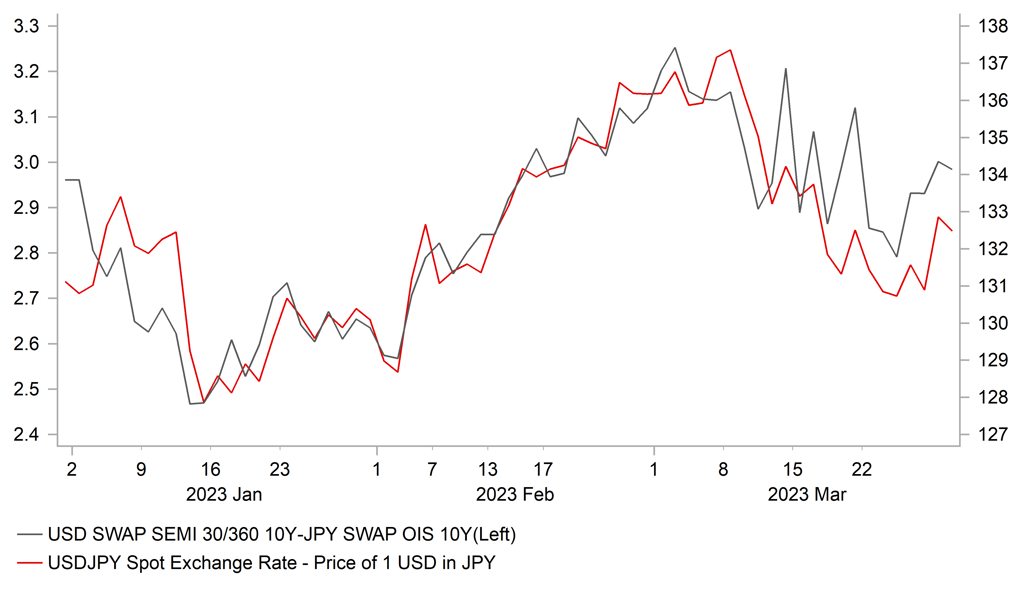JPY gives back some of recent gains as banking fears ease
JPY: US yields & USD/JPY bottom out as systemic banking fears ease
It has been a quieter week for financial markets so far which has provided some relief following the recent collapse of Silicon Valley Bank and heavy deposit outflows from Credit Suisse that prompted the Swiss authorities to step in to force through a merger with UBS. The lack of fresh signs of distress this week in the banking sector has seen European and US regional bank shares stabilizing at significantly lower levels following the heavy sell-offs in recent weeks. The developments have allowed US rates to bottom out in the near-term. The 2-year US Treasury bond yield has climbed back above its’ 200-day moving average that comes in at just below 4.00% after hitting an intra-day low of 3.55% on 27th March. The price action has been similar at the long end of the US curve although the scale of the moves remain relatively smaller. The pick-up in US yields from last week’s lows has helped USD/JPY to bottom out as well which should come as no surprise given it has been the G10 FX pair with the strongest correlation to US rates. After hitting an intra-day low of 129.64 on 24th February, USD/JPY has risen back up to an intra-day high yesterday at 132.89. The impact of banking fears on the FX market has been much more modest than on global fixed income markets. It is the second time this year already that USD/JPY has found support at just under the 130.00-level after it failed to break below on sustained basis back in January and early February on the back of heightened speculation over a further shift in BoJ policy.
The reversal of recent yen gains reflects that investors have become less concerned for now over the risk of a bigger negative systemic shock coming from the banking system although the loss of confidence is expected to result in tighter credit conditions and less lending into the economy than would otherwise have been the case that will put a dampener on the global growth outlook. It is for this reason that US rate market participants remain reluctant to price back in further rate hikes for the Fed. It sets a much higher bar for US rates to regain higher levels that were in place prior to the collapse of Silicon Valley Bank earlier this month. As a result, we now believe it is more likely that USD/JPY will settle in the low 130.00’s for now rather than quickly retracing its steps back to the high from 7th March at 137.91. The yen should derive more support in the month ahead as well from building speculation over a further shift in YCC policy settings in the run up to new Governor Ueda’s first policy meeting on 28th April. Our Tokyo analysts still expect the BoJ to abandon YCC in Q2 but have recently delayed the timing from the April to June in response to recent banking disruption. However, they are becoming more confident that the BoJ will exit negative rates later this year.
A HIGHER HURDLE FOR US YIELDS & USD/JPY TO REBOUND

Source: Bloomberg, Macrobond & MUFG GMR
EM FX: Resilience so far to banking strains in developed markets
The negative fallout from the pick-up in banking fears this month on emerging market currencies has been relatively modest so far. MSCI’s emerging market currency index is currently trading close to its highs for the month. Similar to G10 FX, most emerging market currencies are well on course to strengthen against the US dollar in March. The best performing emerging market currencies have been the COP (+5.4% vs. USD), CLP (+4.2%, THB (3.1%) and PLN (2.8%). In contrast, only the ARS (-5.4%), RUB (-2.9%) and TRY (-1.4%) have weakened against the US dollar. The resilience of emerging market currencies highlights that investors are not overly concerned at this stage over the risk of a bigger hit to the global growth outlook from recent banking sector disruption in developed markets. The outperformance of the CLP and the THB which are two of the more popular China reopening trades could reflect as well the emergence of stronger growth in China that is providing more support. The absence of a broader retrenchment from risk assets has allowed emerging market currencies to benefit more from the pullback in US yield and the US dollar. Two of the currencies that were hit that hardest initially by position adjustment when banking fears first emerged earlier this month were the HUF and MXN. The initial pick-up in financial market volatility triggered a sharp squeeze of those popular carry positions but those losses have since been reversed almost as quickly. The HUF has also benefitted this week for the NBH’s continued commitment to maintain rates at around 18.0%.
KEY RELEASES AND EVENTS
|
Country |
GMT |
Indicator/Event |
Period |
Consensus |
Previous |
Mkt Moving |
|
EC |
09:00 |
ECB Economic Bulletin |
-- |
-- |
-- |
!! |
|
GE |
13:00 |
German HICP (YoY) |
Mar |
7.5% |
9.3% |
! |
|
US |
13:30 |
GDP (QoQ) |
Q4 |
2.7% |
2.7% |
!!! |
|
US |
13:30 |
Initial Jobless Claims |
-- |
196K |
191K |
!!! |
|
US |
17:45 |
FOMC Member Barkin Speaks |
-- |
-- |
-- |
! |
|
US |
20:45 |
Treasury Secretary Yellen Speaks |
-- |
-- |
-- |
!! |
Source: Bloomberg

